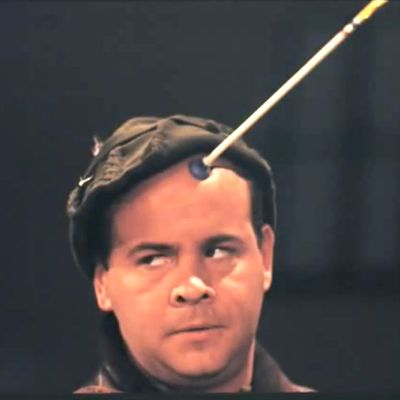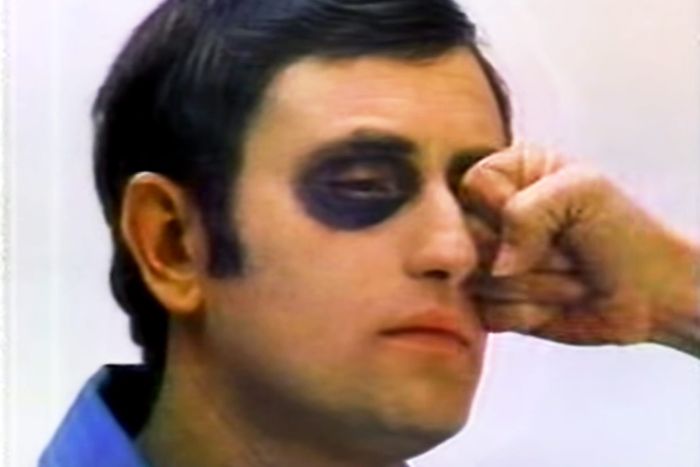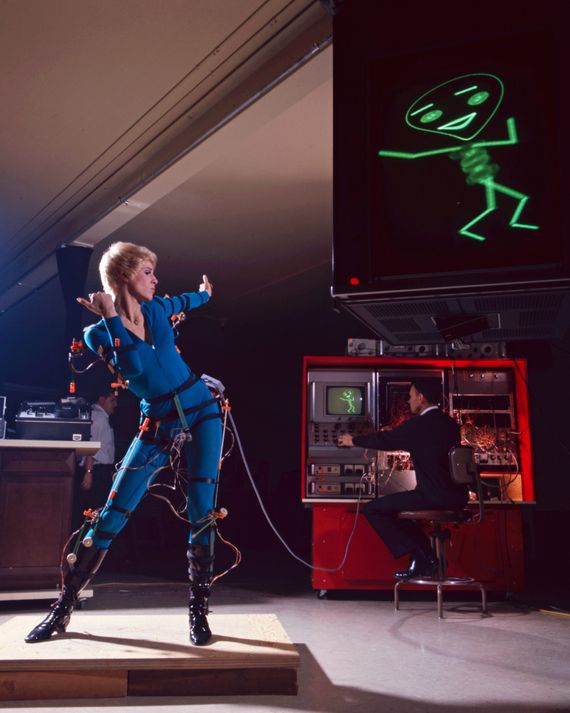
In 1968, Rowan & Martin’s Laugh-In was the envy of the Big Three networks. The sketch comedy landmark wasn’t just a ratings monster for NBC, but a bona fide cultural phenomenon crystallizing the wild energy of the counterculture into one chaotic hour every Monday night. Hippie-friendly humor, endlessly repeated catchphrases, and far-out interstitials featuring body-painted ladies go-go dancing their hearts out spoke to the 18-to-34 demographic as if in a native tongue. When Richard Nixon wanted to curry favor with youth voters, he knew that there would be no line more direct to the nation’s rabble-rousers than shaking his jowls and growling “Sock it to me!” on the must-see program.
Naturally, ABC wanted a piece. That year, the top brass brought series creator George Schlatter and his production partner Ed Friendly in for an offer they couldn’t refuse: Make another Laugh-In, but for us. If NBC was going to use skin, taboos, and insouciant anti-establishmentarianism to carve out a reputation as the hippest place on television, ABC would do them one better with the most daring, button-pushing, censor-baiting show the small screen had ever seen. The lure of higher budgets and near-absolute creative control proved sufficient to lure Schlatter and Friendly across town to ABC’s studios, where their next brainchild would be born and their TV empire could begin in earnest. In a randy wink to their earlier success, they named this new endeavor Turn-On.
They produced two episodes of Turn-On prior to its premiere 50 years ago on February 5, 1969. What was supposed to be Schlatter and Friendly’s entrée to the cultural elite was yanked from the schedule in a panicked furor after 11 minutes of broadcasting. The second episode never saw the light of day on public airwaves. Shows canceled after one episode constitute an elite cadre of shame, extraordinary in the swiftness of their demise. To nosedive and crash by the first commercial break, however, is historic. Planes crash, but there is only one Hindenburg.
To understand how such a catastrophic failure could take place in an industry deliberately structured to safeguard against this exact occurrence, it helps to have an understanding of both George Schlatter and his era. He lived to test the suits and thrived on making executives sweat. From its outset, Laugh-In pushed the line with sly yet harsh criticisms of the Vietnam War and cultural reactionaries of every sort. (The sexual revolution, the civil-rights movement, and the antiwar movement all got thumbs-up.) The popularity of Laugh-In and the corollary realization that the people wanted to be challenged convinced Schlatter and the ’60s TV industry alike that anything was possible. They had reason to believe viewers were open-minded people capable of processing whatever weirdness might be thrown at them, as amenable to experimentation as the people behind the camera. All of a sudden, there were no rules, and the biggest shit-stirrer in the biz had just been given free rein to express every artistic whim, no matter how bizarre or potentially off-putting.
“I could do anything,” Schlatter recalled in a 2010 video interview, “and the arrogance of power took over. I’m cocky now, but 40 years ago, with a 50 share? Forget about it. That’s how we sold Turn-On.” (Neither Schlatter, who’s 86 today, nor his team responded to Vulture’s interview requests.) So long as the ideas were coming from his own brain, Schlatter was certain they were worth pursuing all the way into the avant-garde fringe. But he had been written a blank check on what would turn out to be a faulty line of credit.
Schlatter continued: “The whole idea was to arrest the viewer’s attention, without letting them be comfortable in a place.” On top of the imperative to raunch up the content of the show, he wanted to push the envelope formally as well. He draped his soundstage in infinite white to simulate an absence of environment rather than a traditional set lending itself to a multi-camera setup. For his score, he used the incessant, mechanic clicking of the then-nascent Moog synthesizer in place of a house band or canned music. He eschewed the live studio audience completely, refusing to insult his viewership’s intelligence by instructing them on when and how hard to laugh. Though one sight gag does involve the camera panning to a pair of bleachers seating a dozen onlookers clad in Ku Klux Klan uniforms.
Schlatter ensconced this alienation offensive in the conceit of a “computerized TV show,” in which sketches were chosen at random by a pair of operators behind a gigantic control panel. They’d twiddle a knob or flip a switch and some new amusement would pop up in the blank space surrounding them. Some sketches were structured as four-panel moving comic strips, others in a more conventionally staged manner, a scant few in the deep end of abstract surrealism. Little animated banners emblazoned with inflammatory slogans like “ISRAEL UBER ALLES” occasionally floated across the screen, and interludes of puppetry or stop-motion were liable to punctuate the action. Across all mediums, sex commanded most of the conversation.
Schlatter assembled a cast of C-listers with an eclectic array of experience (at that point, journeyman actor Hamilton Camp was best known as a folk singer) and a crew of UCLA grads picking up what he was putting down. With a 13-episode order from sponsoring pharmaceutical company Bristol-Myers, they went to work charting the final frontier of comedy and taste. As he prepared to screen the completed pilot for his corporate overlords, Schlatter felt a flash of nerves; the Bristol-Myers higher-ups had a reputation as conservative-minded folks, and may not receive all the gallows slapstick as well as he had hoped. His concerns were misplaced: As soon as the pilot screening had concluded, they bumped his order up to 16 episodes.
The premiere broadcast in February 1969 was, to put it modestly, an immediate meltdown. Wherever a viewer might have drawn the line — at nuke jokes, at accusations of liberal complacency, at sacrilegious birth-control gags — Schlatter crossed it with great relish. Affiliates from across America reported phoned-in complaints jamming up their lines, though Schlatter has alleged that it doesn’t take much to jam up two-line phone systems in Podunk markets. He was referring in specific to Cleveland, where “just one wacko” at WEWS decided to pull the program between the first and second commercial breaks. The affiliate notified ABC that the good people of Cleveland would no longer receive Turn-On with a telegram: “If your naughty little boys have to write dirty words on the walls, please don’t use our walls.” A local organist on a never-exercised retainer was then called upon to do his duty, for the first time in 20 years of employment, and filled the remaining airtime with sprightly organ music while the screen remained pitch-black.
In a 2008 interview on PBS, the doomed episode’s guest host, Tim Conway, recalled that back in Los Angeles, the news of the backlash arrived so quickly that Schlatter figured he could save a few bucks by rebranding Turn-On’s debut party as a farewell party. He cut his losses and redirected his attention to executive-producing Laugh-In full time until it wrapped in 1973, eventually producing a revival of sorts for NBC in 1977 featuring a soon-to-be-discovered Robin Williams. ABC also remained on positive terms with Schlatter by cutting him a deal in which he’d get a full payout for the 16-episode order if he would accept that the two finished episodes would never again enter American living rooms. He took it, and Turn-On dissolved into myth.
There’s only one place on Earth that a person can watch the extant episodes of Turn-On: the vast TV video collection at the Paley Media Center in midtown Manhattan, just around the corner from Radio City and NBC’s current studios at 30 Rockefeller Plaza. Any schmo off the street can simply walk in, present a valid form of identification, and get the full down-low on an engrossing TV-history footnote shrouded in rumor and chuckled half-recollections. Turn-On has been sitting there, waiting to reveal its mysteries to any curious party.
To a viewer in 2019, most of the content of these two episodes falls into one of two categories. The first encompasses that which a modern viewer can scarcely believe would have ever been put on a major network: the aforementioned KKK bit, a disturbing infomercial for a foot fetishists’ fan club, a dash of blackface. Some of this material hits the satirical mark — as in one sketch culminating with the white man swearing-in the first black Supreme Court justice saying, “Congratulations, boy,” in a compact expression of white condescension to even the highest levels of black success — and some decidedly misses, such as a particularly punchy punchline about the upsides of domestic abuse. In the most memorable bit, an anthropomorphized Star of David with an oversize schnoz says to a Christian monk, “We’ll forget about Auschwitz if you reduce the charges to manslaughter!” It remains one of the most blithely anti-Semitic things I’ve seen from the American TV industry. That said, I cannot claim that I did not laugh.
Conversely, the other category covers that which a modern viewer can scarcely believe would have gotten a rise out of viewers at the time. Much of Turn-On’s then-objectionable writing relies on suggestions no more off-color than might be seen on the average Thursday-night comedy today. A more devious impulse motivates, say, the sketch in which a firing squad pointed at a buxom beauty waggles their eyebrows when asked if they’ve got any last requests. But that leaves plenty at which you or I wouldn’t bat an eye. An extreme close-up of a belly button drawn on to resemble a sinkhole is more odd than explicit, and most of the jokes about the spooky new Pill scan as palatable commentary on women’s reproductive health instead of provocation. At one point, a woman pops a quarter into a vending machine spitting out birth control, and starts tearing it apart when it eats her coin. At another, the Edenic serpent muses, “Hey, I could’ve given Eve the apple and the Pill!”
Everything outside of that dichotomy is outright incomprehensible. Schlatter had convinced himself that Turn-On would be no common sketch program, but a work of boundary-busting, live-wire artistry, leading to a dizzying mishmash of creative modes, evoking a variety program as directed by Andy Warhol. Loose images break up the space between proper comic sketches, springing a Kuleshovian association game on unwitting viewers with frenetic editing. Non-diegetic shots like a slow-motion bullet shattering a red light bulb to smithereens, or amorphous swirls of color independent of shape, made audiences at the time feel like they’d eaten a bowl of Cheerios soaked in mescaline — a delicacy promoted on this very program.
Whether Schlatter is guilty of letting his ego get away from him or merely thinking too highly of the public’s viewing sensibility, he made a bad bet and lost. At least, that’s how it felt in 1969. Posterity, on the other hand, has a strange way of favoring the bold.
Eight years before Turn-On mortified ABC, FCC chairman Newton Minow infamously appraised the state of American TV as a “vast wasteland.” He felt despondent over what he saw as a decline in quality on the small screen, as “community responsibility,” “the advancement of education and culture,” and “decency and decorum in production” took a back seat to “blood and thunder, mayhem, violence, sadism, murder, western bad men, western good men, private eyes, gangsters, more violence, and cartoons.” If the Minow of 1961 had gotten an eyeful of Turn-On, he would’ve had a thrombosis. If the man making that speech watched three minutes of television on any channel in the year 2019, my guess is his head would explode like the guy from Scanners.
Minow’s scolding schoolmarm tone echoes that of Schlatter’s pals back at WEWS who sent him that “naughty little boys” telegram. The pushback came from a position of moral superiority, as if cultural watchdogs had to stand tall against the barbarians at the gates for fear of large-scale societal decline. (Though an ABC executive got out in front of this narrative by noting that Dean Martin and the Smothers Brothers often worked blue, but that they never got in trouble because “they’re funny.”) In Turn-On, the pearl-clutchers saw a chilling vision of a future without modesty or virtue. They were, at most, half-right.
Listening to interviews with Schlatter and Conway — the second episode’s co-hosts, spouses Robert Culp and France Nuyen, haven’t discussed the gig much — the consensus agreement among the staff seems to be that the problem with Turn-On was that it was ahead of its time. That’s a comforting rationalization for anyone whose abnormal work has been rejected by regular people, but they’re not just blowing smoke up their own asses. Schlatter would go on to recycle some of the cheekier bits in the later years of Laugh-In, as if to prove how far the dial had moved since 1969. A live-action doodle showing a well-endowed woman squashing her breasts against a billiard table, causing the balls to obediently dash into their pockets when she takes her shot, may have turned heads on Turn-On. But on a 1977 Laugh-In featuring icon of aw-shucks goodness Jimmy Stewart, it barely registered. Same goes for the extreme navel close-up.
In his capacity as a profaner, Schlatter was a prophet. As a satirist, he was a relic. Watching Turn-On through modern eyes clarifies so much about the shifting nature of vulgarity and offensiveness, the battleground issue over which countless scores of Twitter users and political pundits have slowly lost their minds. Conservatives love pointing out that liberals have assumed the station of Censor General, the one-time province of tongue-cluckers with prudish sensibilities. The gap between what got Turn-On pilloried at the time and what ruffles feathers today reveals just how broad a brush one would need to paint with for such an assessment to make sense.
We’ve gradually divorced these concepts of vulgarity and offensiveness from one another, removing the stigma from sexuality and other forms of “obscenity” and appending it to intolerance. We’ve come to understand graphic content as “mature” rather than “dirty,” while racially insensitive writing that may have once been praised as “risky” now assumes the scarlet A of “politically incorrect.” The difference between viewers who called for the cancellation of Roseanne and those who rose up in outcry over a same-sex kiss on the Macy’s Thanksgiving Day Parade could not be clearer.
The curious case of Turn-On illustrates the complete reversal that’s taken place regarding which art makes which people mad. The human body doesn’t outrage the populace like it used to, and today’s boundary-pushing TV-makers perhaps have Schlatter to thank for clearing the way, for choking out in the hostile atmosphere of double entendre so that others in the future might learn how to survive. But as much as TV might owe Schlatter for forcing it through an awkward adolescence via both Laugh-In and Turn-On, it had to leave part of the latter’s mentality behind to continue evolving. The show was built around the impulse to shock, and not all shock is created equal. Schlatter reasoned that if he was getting angry phone calls, he must have been doing something right, and he wasn’t totally incorrect. From the culture-baiting tykes of South Park to the unleaded insanity of Wonder Showzen (the truest heir to Turn-On’s legacy of furious Dada rib-tickling), the power to offend has been a mighty sword that can develop a double-edge if those wielding it aren’t careful. The generations that followed Schlatter continued his noble quest to grab heavy-lidded TV viewers by the lapels and shake them awake — only with a bit more thought paid to the questions of how and why.






